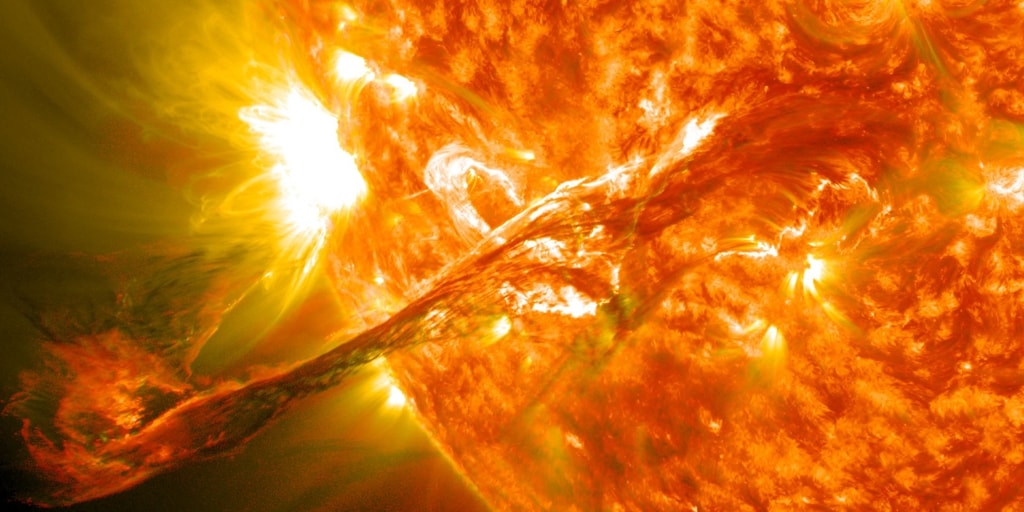The largest solar storm in history was more powerful than previously thought

This week, Earth experienced the strongest geomagnetic storm since 2017, after the Sun unleashed a powerful coronal mass ejection our way. According to him National Oceanic and Atmospheric Administration Space Weather Prediction Center (NOAA), the event has arrived “Severe” levels.Although it did not have serious consequences for satellites and electrical grids. Despite this, the National Oceanic and Atmospheric Administration (NOAA) sent a notice to all infrastructure operators “to take measures to mitigate any potential impact.” In fact, the level of solar activity recorded these days had the potential to cause interference in high-frequency radio signals used in air, sea and military communications, and also posed a “slight risk” of blackouts in electrical grids.
But that's nothing compared to what is by far the largest solar storm in recorded history, the so-called “Carrington event.” On September 1, 1859, the Sun shot a fiery cloud of plasma made up of electrified gas and subatomic particles toward Earth, with the energy equivalent of 10 billion atomic bombs. The attack was brutal, causing breakdowns and spontaneous fires at many stations of the telegraph network, the only electrical communications facilities at the time. The northern lights have been recorded as far south as Cuba and Hawaii, and they were so bright you could read the newspaper at midnight.
It goes without saying that if something like this happened today, it would be a real catastrophe, and its consequences would be catastrophic for electrical networks, computer networks, navigation and communications systems. The world as we know it, according to experts, will collapse in 2018. It is only a matter of a few minutes. Now, in a study recently published in 'Space climateA team of researchers from the British Geological Survey in Edinburgh and Nagoya University in Japan show that the Carrington event was, if possible, larger than previously thought. In fact, it was so large that it far exceeded the capacity of the measuring devices of the time.
Inaccurate data
Most of what we know about the Carrington Event comes from contemporary descriptions and measurements made by astronomers, such as the Englishman Richard Carrington himself, to whom the solar storm owes its name, or from magnetic records taken at the time from various observatories. However, none of these sources of information contain precise data or specific numbers describing the true magnetic intensity of the storm, so it is difficult to know exactly how strong it is compared to what we are seeing today.
Now, geophysicist Kieran Beggan (director of the study) and his colleagues have digitized recordings (preserved on paper) of the magnetic field made during the Carrington event at two observatories in London, at Kew and Greenwich. It was discovered that the intensity and speed of change in the magnetic field during the storm was much greater than previously thought. Bad news for an increasingly connected world with more and more energy needs.
The light is reflected on the paper
As early as 1838, he began measuring local terrestrial magnetism at Greenwich by shining light on mirrors at the ends of magnetized pieces of metal suspended so that they could oscillate freely, while the reflected light fell on photosensitive paper. Kew also started making this type of measurement two years before the big storm.
The system, of course, was ingenious. When solar activity disturbed Earth's magnetic field, the magnet buckled, causing light to move across the sheet. The stronger the disturbance, the more the light moves.
Unfortunately, none of these systems were built in anticipation of the Earth's magnetic field taking a hit as strong as the one it suffered in 1859. As a result, the metal holding the mirror oscillated so much that the light beam “popped” off the paper Photograph during a magnetic storm that It occurred 12 hours before the Carrington event, and again during the same event. Such large movements indicate a very strong event, although unfortunately they do not tell us how strong it was.
More data than thought
However, when Beagan and his team digitized these magnetic records, they discovered that they contained more information than they seemed. According to the researchers, the photographic paper is “in relatively good condition considering its age and preservation.” Once all the records were photographed and digitized, the team was able to create a continuous sequence and study them as a whole.
Thus, by measuring the speed of movement of light rays before they left the paper and after returning to it, the study authors calculated the speed at which the field changed, which they estimated at a minimum of 500 nanotesla per minute. This is already an unusually high value if we take into account that only one storm per century is expected to be able, at the latitude of London, to produce changes of between 350 and 400 nanotesla per minute. For Beagan, this means that the Carrington event may have been much more extreme than those that typically occur once every century, and that it may have reached values estimated to occur only once every thousand years.
In 1861, two years after the Carrington Incident, a scientific article reached similar conclusions. But 20th-century astronomers, who had never before measured anything of this size, concluded that those original estimates were overstated. Now, Beagan and his team support these early conclusions.
The result is that the Carrington event, the largest solar storm ever recorded by humans, was much more powerful than previously thought. There's another reason to take space weather seriously and the devastating consequences it could have on our current way of life.

“Bacon advocate. Certified creator. Twitteraholic. Tv junkie. Beer fanatic. Internet nerd. Passionate thinker. Reader.”




:quality(85)/cloudfront-us-east-1.images.arcpublishing.com/infobae/OF4NJDPGLBEYJAZ5XZMH3OIPJ4.jpg)



